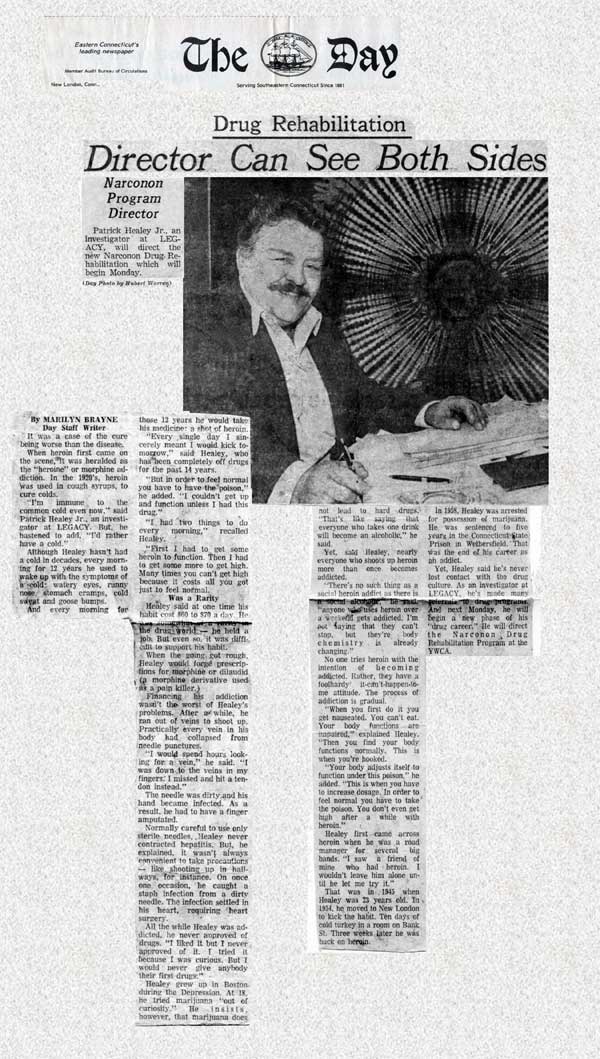Interview With Narconon Program Director

Article:
The Day Newspaper, New London, Connecticut
Circa 1974
Narconon Program Director
Patrick Healey Jr., an investigator at LEGACY, will direct the new Narconon Drug Rehabilitation which will begin Monday. (Day Photo by Hubert Warren)
Drug Rehabilitation Director Can See Both Sides
My MARILYN BRAYNE
Day Staff Writer
It was a case of the cure being worse than the disease.
When heroin first came on the scene, it was heralded as the “heroine” of morphine addiction. In the 1920’s, heroin was used in cough syrups, to cure colds.
“I’m immune to the common cold even now,” said Patrick Healey Jr., an investigator at LEGACY. But, he hastened to add, “I’d rather have a cold.”
Although Healey hasn’t had a cold in decades, every morning for 12 years he used to wake up with the symptoms of a cold; watery eyes, runny nose, stomach cramps, cold sweat and goose bumps.
And every morning for those 12 years he would take his medicine: a shot of heroin.
“Every single day I sincerely meant I would kick tomorrow,” said Healey, who has been completely off drugs for the past 14 years.
“But in order to feel normal you have to have the poison,” he added. “I couldn’t get up and function unless I had this drug.”
“I had two things to do every morning,” recalled Healey.
“First I had to get some heroin to function. Then I had to get some more to get high. Many times you can’t get high because it costs all you got just to feel normal.”
Was a Rarity
Healey said at one time his habit cost $60 to $70 a day. He was somewhat of a rarity in that drug world – he held a job. But even so, it was difficult to support his habit.
When the going got rough, Healey would forge prescriptions for morphine or dilaudid (a morphine derivative used as a pain killer.)
Financing his addiction wasn’t the worst of Healey’s problems. After a while, he ran out of veins to shoot up. Practically every vein in his body had collapsed from needle punctures.
“I would spend hours looking for a vein,” he said. “I was down to the veins in my fingers. I missed and hit a tendon instead.”
The needle was dirty and his hand became infected. As a result, he had to have a finger amputated.
Normally careful to use only sterile needles, Healey never contracted hepatitis. But, he explained, it wasn’t always convenient to take precautions, – like shooting up in hallways, for instance. On once one occasion, he caught a staph infection from a dirty needle. The infection settled in his heart, requiring heart surgery.
All the while Healey was addicted, he never approved of drugs. “I liked it but I never approved of it. I tried it because I was curious. But I would never give anybody their first drugs.”
Healey grew up in Boston during the Depression. At 18, he tried marijuana “out of curiosity.” He insists, however, that marijuana does not lead to hard drugs. “That’s like saying that everyone who takes one drink will become an alcoholic,” he said.
Yet, said Healey, nearly everyone who shoots up heroin more than once becomes addicted.
“There’s no such thing as a social heroin addict as there is a social alcoholic,” he said. “anyone who uses heroin over a weekend gets addicted. I’m not saying that they can’t stop, but they’re body chemistry is already changing.”
No one tries heroin with the intention of becoming addicted. Rather, they have a foolhardy it-can’t-happen-to-me attitude. The process of addiction is gradual.
“When you first do it you get nauseated. You can’t eat. Your body functions are impaired,” explained Healey. “Then you find your body functions normally. This is when you’re hooked.
“Your body adjusts itself to function under this poison,” he added. “This is when you have to increase dosage. In order to feel normal you have to take the poison. You don’t even get high after a while with heroin.”
Healey first came across heroin when he was a road manager for several big bands. “I saw a friend of mine who had heroin. I wouldn’t leave him alone until he let me try it.”
That was in 1945 when Healey was 23 years old. In 1954, he moved to New London to kick the habit. Ten days of cold turkey in a room on Bank St. Three weeks later he was back on heroin.
In 1958, Healey was arrested for procession of marijuana. He was sentenced to five years in the Connecticut State Prison in Wethersfield. That was the end of his career as an addict.
Yet, Healey said he’s never lost contact with the drug culture. As an investigator of LEGACY, he’s made many referrals to drug programs. And next Monday, he will begin a new phase of his “drug career.” He will direct the Narconon Drug Rehabilitation Program at the YWCA.
The program will begin at 7:30pm for two-hour sessions at least three days a week, Monday, Wednesday and Friday. The cost is $30 for the ten-week course.
The program, based on eight communication drills, is for detoxified addicts only. Healey said he does not have the staff or facilities to handle hard-core addicts.
Other Articles from 1974: